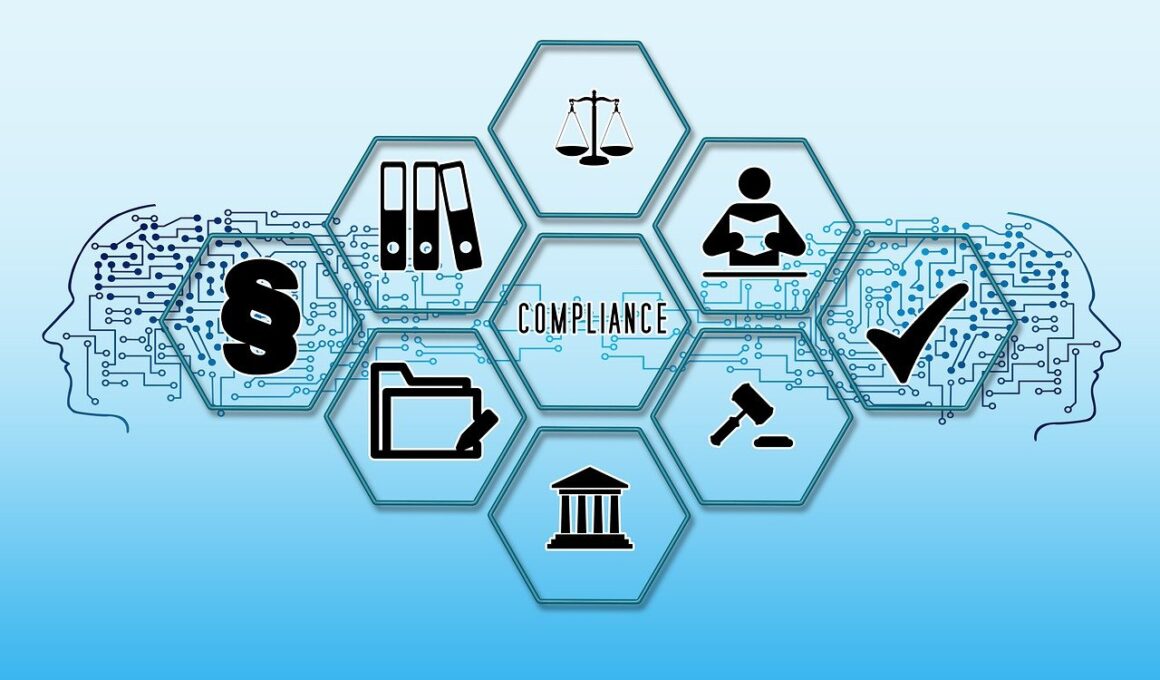Developing Training Programs for Compliance and Regulatory Risk
In the contemporary corporate landscape, developing effective training programs for compliance and regulatory risk is essential. Companies face a plethora of regulations that require them to ensure adherence. Proper training not only equips employees with the necessary knowledge but also fosters a culture of compliance within an organization. This proactive approach can mitigate risks related to non-compliance, which may result in heavy fines or reputational damage. Key elements to consider include identifying training needs through comprehensive assessments. These assessments should pinpoint specific gaps in knowledge and understanding among employees. Once these needs are identified, organizations can tailor training content accordingly, ensuring relevance and effectiveness. Utilizing various training methods is crucial; these can include online modules, workshops, and interactive sessions. Engaging employees in multiple formats aids retention and understanding. Additionally, compliance training should be reinforced regularly to keep it fresh in employees’ minds. Furthermore, using real-life scenarios and case studies can significantly enhance the realism of training. By embedding compliance into the company culture, organizations can foster an environment where employees adhere to regulations with confidence and understanding.
Another critical component in developing compliance training is evaluating its effectiveness regularly. After training programs are executed, gathering feedback from participants can provide invaluable insights. Assessing the training’s impact through surveys or follow-up quizzes can clarify if employees have understood the material presented. Furthermore, organizations should track compliance metrics to determine if adherence levels have improved following the training sessions. If gaps persist, it may indicate that the training content needs refining or that additional sessions are necessary. Continuous improvement is essential, and lesson learning from each training exercise is crucial. Additionally, a clear communication channel must be established regarding regulatory changes. Compliance is not static; thus, it necessitates ongoing attention and updates. Companies should designate a compliance officer or team responsible for monitoring changes in legislation and regulations. This team should collaborate closely with staff to ensure everyone remains informed. Tailoring training to address new regulations helps maintain compliance readiness. Lastly, firms should look to industry best practices when developing these training programs. Benchmarking against competitors can provide insights into effective methodologies and innovative approaches within the sector.
Engaging Employees in Compliance Training
One of the greatest challenges in compliance training is employee engagement. Adult learners, in particular, often demotivate the subject matter due to its perceived dullness or complexity. Organizations can employ various strategies to keep employees motivated during training. Gamification techniques have become popular as a way to enhance engagement levels. Incorporating elements such as points, rewards, or challenges can make compliance training more interactive and enjoyable. Additionally, involving employees in the development process can create a sense of ownership and relevance. Soliciting suggestions from employees on training content or methods can help tailor programs to their interests and needs. Furthermore, using multimedia resources such as videos, podcasts, or infographics can cater to different learning preferences. Visual and auditory elements can appeal more to various audiences, enhancing retention. Offering flexible training options, including self-paced online modules, can also enhance participation levels. Employees appreciate having control over their learning schedules. Lastly, creating opportunities for discussion during training can promote peer learning and shared insights, reinforcing the material covered in the training.
Furthermore, compliance training should highlight the real-world implications of regulations to make it more relatable. Employees are more likely to engage with content that feels relevant to their daily tasks and responsibilities. Providing tangible examples or scenarios that employees might encounter in their roles can help crystalize these concepts. For instance, role-playing exercises can allow employees to practice responding to compliance scenarios in a safe environment. This type of practice creates familiarity and confidence in handling compliance challenges. Additionally, management buy-in is vital when implementing effective compliance training programs. Leadership should actively participate in training initiatives to demonstrate the importance of compliance across all levels. When employees see their leaders investing time in learning about compliance, they may perceive it as a priority and embrace the teachings more wholeheartedly. It’s also essential for leaders to model compliant behavior themselves; this establishes a standard and reinforces the message that compliance is not merely a checklist but a valued principle. Encouragement from the top can create a trickle-down effect, fostering a culture that prioritizes regulatory adherence.
Importance of Continuous Education
A culture of continuous education about compliance and regulatory matters is vital for all organizations. It is not enough to conduct a one-off training session and assume that employees will retain knowledge indefinitely. As regulations evolve, so too must the training programs. Regularly scheduled refresher courses should be implemented to ensure that employees remain updated on compliance requirements. Dedicating time for continued education can help accommodate changes in regulations, new laws enacted, and amendments to existing ones. Additionally, it’s beneficial to celebrate compliance successes within the organization publicly. Recognizing employees or departments that demonstrate exemplary compliance behaviors fosters an environment of accountability and commitment. Companies might create an awards program to highlight top performers in compliance adherence. By doing so, these organizations not only maintain regulatory standards but also encourage others to participate positively in compliance initiatives. Creating a newsletter or bulletin that highlights recent regulatory news can keep employees informed of industry updates, demonstrating a commitment to transparency and knowledge sharing. Ultimately, implementing continuous education as a core aspect of compliance training enhances understanding, reduces risks, and promotes ethical behavior across the board.
Moreover, organizations should not underestimate the value of feedback loops in compliance training programs. Creating open discussions about the training’s effectiveness via surveys, focus groups, or suggestion boxes can drive improvements. Employees often have firsthand insights into what works or doesn’t work during training. When organizations act on this feedback, they signal to employees that their voices are valuable and necessary. Involvement in refining programs can thus lead to increased motivation and willingness to participate in future training. Additionally, fostering a supportive environment where questions can be asked freely can alleviate any concerns employees may have regarding the training content. It’s crucial for those leading the training sessions to be approachable and knowledgeable. Employees should feel comfortable seeking clarification or assistance. Furthermore, digital platforms can be utilized for anonymous queries or concerns surrounding compliance topics, ensuring that all employees feel heard and valued. When employees receive support and guidance, they are more likely to embrace compliance training positively, driving a more profound understanding throughout the organization.
Conclusion on Compliance Training Programs
In conclusion, developing robust training programs for compliance and regulatory risk requires careful planning and execution. Organizations must prioritize identifying training needs, employing varied methods, and involving employees in creating a relevant program. Continuous evaluation of training effectiveness and adapting to regulatory changes ensures ongoing adherence. Combining engaging elements with real-world implications makes training material relatable and motivating. Furthermore, instilling a culture of compliance contributes to better performance over time. Employees benefit from ongoing education, which fosters a deeper understanding of compliance issues. Feedback mechanisms can drive continuous improvement and support employee participation. Leadership also plays an influential role by modeling compliant behavior and celebrating successes. Ultimately, effective compliance training programs can protect organizations from the financial and reputational risks of non-compliance. By placing significant importance on training, companies not only adhere to regulations but also promote a culture that values ethical behavior. The positive ripple effects of such training extend beyond mere adherence, fostering greater employee trust, retention, and satisfaction. As regulations continue to evolve, companies can establish a proactive and adaptive approach by implementing training centered around compliance.


